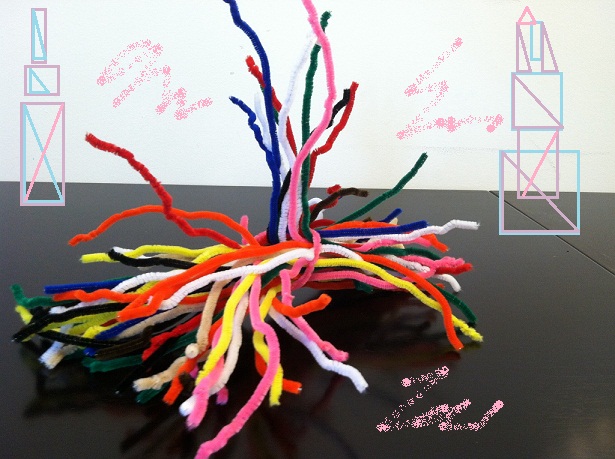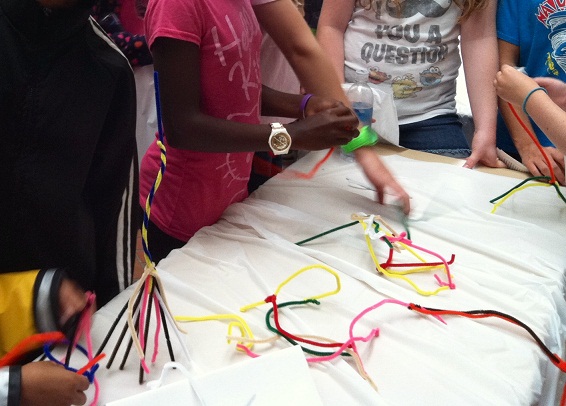Pipe-Cleaner Towers
Activity adapted from The Engineering Place, the North Carolina State University engineering school’s preK-20 outreach program. Click HERE for pdf.
Summary
In this fun for all ages activity, students work in groups of 3-4 to design and build the tallest freestanding tower using teamwork and simple materials while adjusting to changing constraints.
Grade Level: 4-12 (and older)
Time: 20-30 minutes, including 15-20 minutes for the activity
Learning Objectives
After doing this activity, students should understand:
- The concept of limited resources and constraints
- The importance of teamwork and communication
- The importance of planning a project
Standards
Common Core State Mathematics Practice:
- Standard 1: Make sense of problems and persevere in solving them
- Standard 2: Reason abstractly and quantitatively
- Standard 3: Construct viable arguments and critique the reasoning of others
- Standard 5: Use appropriate tools strategically
- Standard 7: Look for and make use of structure
Next Generation Science Standards
- Practices of Science and Engineering 1: Asking questions (for science) and defining problems (for engineering)
- NGSS Practices of Science and Engineering 2: Developing and using models
- NGSS Practices of Science and Engineering 3: Planning and carrying out investigations
- NGSS Practices of Science and Engineering 6: Constructing explanations (for science) and designing solutions (for engineering)
- NGSS Practices of Science and Engineering 8: Obtaining, evaluating, and communicating information
Engineering Connection
Engineers work with many different types of materials and must design within the restrictions of a particular problem or project. Cost, type of materials available, time, and other constraints often dictate many aspects
of a design. This activity helps students to appreciate the planning, resources, and constraints that often govern an
engineer’s work, as well as the benefits of teamwork and diversity.
Related Engineering Disciplines: Civil and/or architectural (structures and design); all disciplines (design process, particularly planning; collaboration).
Engineering Habits of Mind Connection: Creativity, collaboration, optimism, communication
Materials
Each group will need:
- 15 Pipe Cleaners (bundles of 14 with one wrapped around to secure and separate them)
To conduct the activity:
- Stopwatch or timer (phone, computer or interactive white board countdown timer works well)
- Measuring tape or yardstick to measure the tower height at the end of the activity
Safety: Caution students that the ends of the pipe cleaner wires may be sharp.
THE CHALLENGE:
In 7-12 minutes, work with your team to build the tallest freestanding structure using only your team members and 15 pipe cleaners. The height of the structure will be measured from the table/desk top to its highest point and it cannot be propped up, taped down, held, or suspended or attached to anything or anyone.
Introduction
Use the information from the section titled ‘Engineering Connection’ to introduce the activity to students. Tell them that they will be using ‘high-tech’ materials to build the tallest, free standing tower that they can within certain time constraints. Check for understanding on the term ‘free-standing’ by asking one of the students to define it for the rest of the group. Then show the students your high-tech materials: pipe cleaners!
Procedure
Preparation: For each team, count out 15 pipe cleaners. For fast and easy distribution, use one of the 15 to wrap around the remaining 14 pipe cleaners to keep them bundled together in groups of 15.
At time of activity:
- Choose teams of 3-4 students each; to minimize transition time, use natural breaks where they are already sitting
- Pass out bundles of 15 pipe cleaners to each group.
- Tell the students that they will have five to 10 minutes to build. Ask for any questions and then tell them to begin. Typical questions/answers may be: Can we cut the pipe cleaners? No, and there are no other materials you may use, including scissors. How will the tower be measured? The height of the tower will be measured from the base of the tower on the desk/table top to the highest point of the structure. Do we have to use all the materials? No. Tell teams to begin and start the challenge timer
- After 3 to 4 minutes have passed, tell students to freeze. Tell the students that engineers often work within the restrictions of project plans and budgets and that sometimes resources become available or are eliminated after a project has begun. To symbolize this, for the next five minutes, each team member must place one arm behind her/his back. This restriction generally elicits chatter and enthusiasm amongst the group. Tell the students to continue, and that they have three minutes left to build (Modification: you may alternatively take a pipe cleaner from each group to symbolize a budget cut; however, restricting building to one hand per team member forces the students to work together to accomplish their task).
- After another two minutes, stop them again. Tell them that, as engineers, we work in a global marketplace. This means being able to communicate with people from many different cultures and countries. Their business has just been purchased by a company based in (insert your favorite esoteric country here— we use Eritrea). Since they do not speak any of the native languages of this country communication is difficult. To symbolize this constraint, the students may no longer talk. Tell them they have one minute to finish.
- Count down from 10 and ask all the students to stop working on their structures. Walk around the room and make note of all the different shapes and designs that the students have created. Compare the towers, commenting on the good points of their design (sometimes the only good thing is to say that they have a future in abstract art) and find the tallest, free-standing structure amongst them. Depending on the age of the students, you may make this a big production. Note: the most successful designs will generally incorporate a small base made from just one pipe cleaner.
- .Ask the students if everyone came up with the same design, and why not? They should answer that they all have different ideas, and this speaks to the importance and role of diversity in engineering and problem-solving. Discuss the different shapes that the teams used for the foundation of their structure, and how they may have used beams and columns to support their structures. Indicate that architectural/civil/mechanical engineers use these same principles, although with different materials, to construct homes, commercial buildings, bridges, and even toys. Finally, wrap up by asking the students if they could do a better job if they performed this activity again or with more time? Tell them that engineers look to improve existing designs and may try things many, many times before they find the optimal solution.
- Cleanup – Tell students that their prize for putting together such inventive designs is that they must return the pipe cleaners to you exactly the way that they received them.
Tips/Troubleshooting
- Adjust timing based on age and abilities of students. If they progress quickly to the tower building, you will need to shorten the time between the change announcements so they are not too far along to feel the constraint. If few groups are having success, give more time between challenges. It’s not important to have equal amount of time for each change to be implemented; flexibility is key. In general older students finish more quickly than younger students. This is an appropriate activity for young children (with more guidance) through adults.
- It is appropriate to aid groups struggling with starting by asking them questions about how (generally) buildings are started (foundation, shapes they’ve seen, etc) to get them moving.
- There is no single correct answer to this problem. Many groups will have a standing structure but at the end when they remove all support, it falls over. It still has height, it just is shorter. Participants tend to get caught up in the “highest” qualification without looking around to see how other groups are doing. Often, a more stable but shorter structure will “win” because the higher towers may not stand up.
- If pipecleaners are have been used before, particularly multiple times, the challenge is greater. It can be done, and is often a good learning experience for students. During the wrap up discussion, this is usually mentioned as a problem if it applies.
Discussion
There are many interesting discussion questions that arise from this activity, including:
- Ask the students if everyone came up with the same design, and why not?
Some good points to look for in their answers include that they all have different ideas, (this speaks to the importance and role of diversity in engineering and problem solving).
- Discuss the different shapes that the teams used for the foundation of their structure, and how they may have used beams and columns to support their structures.
Indicate that architectural/civil/mechanical engineers use these same principles, although with different materials, to construct homes, commercial buildings, bridges, and even toys.
- Which of the two changes to the constraints was the most frustrating (hand behind back or not being able to talk) and why? This is generally evenly split among participants, although adults usually cite the inability to talk as the larger problem.
- Ask the students how their teams worked together—for example did the members have different roles or did all work on the same thing?; did they plan before building?, etc.
- Conclude by asking the students if they could do a better job if they performed this activity again. What kinds of things would help? Examples may be more time, more people, no changes, etc. Tell them that engineers have a process they follow that includes time and effort to improve existing designs and in that process they may try many, many times before they find the optimal solution.
Activity/Age Scaling
As the students are working, assess how quickly they are completing the task and be flexible on time. Older students will finish this activity more quickly, while younger students may be paralyzed by the planning stage. If the groups are succeeding too fast, shorten the time between challenges. If few groups are experiencing success, givemore time between challenges.
Depending on the age of the students, you may need to assist them in beginning or planning their structure. Ask any
struggling individuals or groups what every building begins with – a foundation, and to consider what shape it could be. This should help to get them moving in the right direction.
Additional Resources
Building challenges are a great way to engage students in teamwork while they learn about architectural, civil, environmental, and structural engineering. Here are some fun, teacher-tested activities:
- Tall Tower Challenge. From IEEE’s TryEngineering.org, this activity for students 8 to 18 uses pipe cleaners, plastic straws, and paper clips to convey structural engineering concepts, including strength.
[youtube]http://www.youtube.com/watch?v=E0zj1IaRbPM[/youtube] - Marshmallow Design Challenge. A hit with kindergarten kids and CEOs alike, the competition asks teams to build the tallest freestanding tower that can support a marshmallow using 20 pieces of uncooked spaghetti, three feet of masking tape, and three feet of string.
- Build a Paper Tower. Activity from PBS’s Building Big series for students in grades 5 -12.
- Leaning Tower of Pasta. Students in grades 5 to 7 build towers using marshmallows and spaghetti to test load-bearing properties.
Kickstarter: Pipe Cleaner Tower Challenge. Watch three students compete to build the tallest freestanding pipe cleaner tower on WPXT’s game show for Maine 8th graders. [YouTube – first 1o minutes of 22:31 video]
Contributors: Dr. Laura Bottomley & Heather Smolensky
Filed under: Class Activities, Grades 6-8, Grades 9-12, Grades K-5, K-12 Outreach Programs
Tags: build, Building Design, Civil Engineering, Class Activities, Design, design contest, Grades 6-8, Grades 9-12, Grades K-5, North Carolina State University, pipe cleaner challenge, pipe cleaners, STEM education, Structural Engineering, tower










